
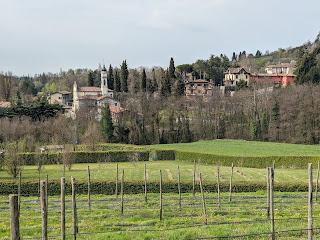


Upper left: Looking over a tilled field and view toward Monastero d'Astino.
Upper right: View toward Madonna del Bosco, a small hamlet northwest of Bergamo.
Lower left: A scarecrow advertises Ortinsema - a project of shared gardening.
Lower right: Rows of Prunus trees in the Valle d'Astino.
Overview
Length: ~ 11 km (6.8 miles)
Duration: ~2.5 hours
Elevation: gain 410 m (1,345 ft), max elevation at 460 m (1,510 ft) San Vigilio
Location: Italy, Lombardy, Bergamo
Notes
The Astino Valley (La Valle d'Astino) is a small valley in the Bergamo hills and a favorite walking spot of the locals. Today, we got a ride to Astino with a friend and explored the Laudato Si trail and then headed back home on foot. You can catch a bus to the start of the valley (10 bus from to Loreto/Longuelo e.g.) and do the same. Or, if you are staying the upper city, just walk to the valley, following via Sudorno to via Astino.
The valley contains the Astino Abbey (founded 1070) and associated church, Chiesa del Santo Sepolcro. In "normal" times, i.e., non-pandemic, the monastery is a place of art exhibitions and summer dining in the open. (And it will be again.) Across the street from the monastery there is the Valle della Biodiversità – Sez. di Astino dell'Orto Botanico di Bergamo, a gardening area and performance venue set into the hill. During late summer you can buy vegetables grown in the garden, see a performance, or just enjoy the view.
The Valle d'Astino recently was announced the winner of the Premio Nazionale del Paesaggio, or the "National Landscape Award" for 2021. What does this mean? Glad you asked. Well, we have to start with the Council of Europe's landscape award. The Council of Europe (distinct from the European Union) landscape award "is intended to raise civil society’s awareness of the value of landscapes, of their role and of changes to them." (ref) Since 2007, the Council of Europe award has been given every two years to parties to the European Landscape Convention, such as Italy. Italy's award (Premio del Nazionale del Paesaggio that Astino won) is a feeder for candidates for the Council of Europe's award.
Today's objective was to re-explore the Laudato Si trail with our friend. We had passed by this way back in November as describe in our post A Walk from Bergamo to Monte Gussa. In that post, we went "high" and followed trails to Monte Gussa. Today's walk, we stay low and follow the road (more like a country lane) called Via Castello Presati.![[Lamiaceae] Lamium purpureum - Purple Deadnettle in the fields of Astino. [Lamiaceae] Lamium purpureum - Purple Deadnettle in the fields of Astino.](https://blogger.googleusercontent.com/img/b/R29vZ2xl/AVvXsEgqML7irMtDfCYP6GdqMB97PeJmvoTaucOOykV6ig1O4J2VUn4fPC8PcyNCjx_Gizcz_bqd1_9mtHAG81sJdoLP676UUJtoxkrhdhLvQjLPWppyqn93egXOYstrYBAWcX6X6kNmsLp-K2c/s320/%255BLamiaceae%255D+Lamium+purpureum.jpg)
![[Ranunculaceae] Ficaria verna - Fig Buttercup, Lesser Celandine. [Ranunculaceae] Ficaria verna - Fig Buttercup, Lesser Celandine.](https://blogger.googleusercontent.com/img/b/R29vZ2xl/AVvXsEjmknvrD74dHql7rSfCFwTR2mptC4inWVC3eJZpHMWaXOprNzxapBSXbK_ed476J2hzeHaBQivs5lfb1pYh0y7LB5n742YgxFGetWj27WKZ4bRSIHo-d1fk5cWzZ4ovX9lHdw7p1mnsi-g/s320/%255BRanunculaceae%255D+Ficaria+verna.jpg)


Left: [Lamiaceae] Lamium purpureum - Purple Deadnettle in the fields of Astino.
Center left: [Ranunculaceae] Ficaria verna - Fig Buttercup, Lesser Celandine.
Center right: Prunus sp. blossom.
Right: Sign explaining a project to plant flax (Linum usitatissimum) and cannabis (Cannabis sativa) for textile use.



Left and center left: An old church - structure and door detail on Via Castello Presati.
Center right: A horse and carriage on Via Castello Presati.
Right: Chiesa Madonna del Bosco.

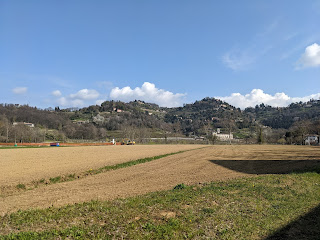
Plowed fields in Valle d'Astino.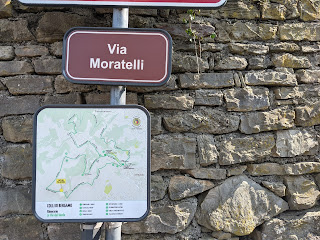
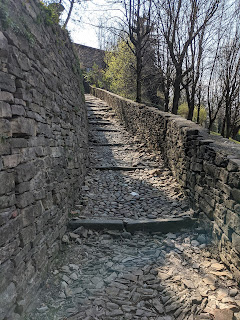

Left and center: The trail / stairs named Scalinata Moratelli. This is a fun way to enter or leave the Astino valley.
Right: The tracks on ViewRanger.
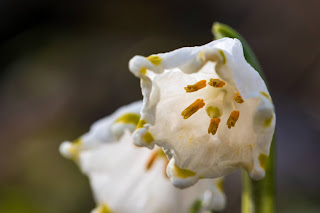




![[Amaryllidaceae] Leucojum vernum – Spring Snowflake {Campanelle comuni} [Amaryllidaceae] Leucojum vernum – Spring Snowflake {Campanelle comuni}](https://blogger.googleusercontent.com/img/b/R29vZ2xl/AVvXsEiOzOn_wDZHbocNMjXkJOxsiVXxd8MqCqBSfTA-XHN-qHmeHKKCtrEF-NY90w62viaIinzsLfLLevzaG5roSgrXncDfJOkqSeN4lK03vSFl7BZ95LWYS0ANcVbqlUWEAcDd2xItSd7CwMo/s320/%255BAmaryllidaceae%255D+Leucojum+vernum+1.jpg)
![[Amaryllidaceae] Leucojum vernum – Spring Snowflake {Campanelle comuni} [Amaryllidaceae] Leucojum vernum – Spring Snowflake {Campanelle comuni}](https://blogger.googleusercontent.com/img/b/R29vZ2xl/AVvXsEh9iVdlGlLMOWzv22fNb1t_C-5U6pi8jaYQAtVz-1maH8xJCSAIdUwJS7H88c0M-iPkphMpyJx5k_TBN37js6pEqRBKD67EuqzZ-OY265funOvPIeJpxlZ75txxUuVYy5aFZ_eJkl10tN4/s320/%255BAmaryllidaceae%255D+Leucojum+vernum+3.jpg)
![[Amaryllidaceae] Leucojum vernum – Spring Snowflake {Campanelle comuni} [Amaryllidaceae] Leucojum vernum – Spring Snowflake {Campanelle comuni}](https://blogger.googleusercontent.com/img/b/R29vZ2xl/AVvXsEjiGJGX9Vy1eULW3IivqIUkMZNERUT2p9EMVWy-BZyF2HoMVPEVwd7dUMA8KWB6TTZb9wAj2EspyF7YhPwHxQEKqMciMNI-xyiS8DQIenW69odCnetU4vOC90oEbmpHDoG3Asc4eBE9lHs/s320/%255BAmaryllidaceae%255D+Leucojum+vernum+4.jpg)
![[Asplenianceae] Asplenium scolopendrium – Hart's Tongue Fern {Scolopendria comune} [Asplenianceae] Asplenium scolopendrium – Hart's Tongue Fern {Scolopendria comune}](https://blogger.googleusercontent.com/img/b/R29vZ2xl/AVvXsEhW__oCEW2-56Ht86mZxEc8y_26Q_JDnpP3nh4Kqom2eRRSPffMAX5GGpTN7mJXynxF6d0hl-70k9WFf-bAEWRRFZxFQX20mEmTUrAVjvUBSWBWlvpGaFtTQ-VNvX_nz4jAivL3aNBaEXQ/s320/%255BAsplenianceae%255D+Asplenium+scolopendrium+1.jpg)
![[Asplenianceae] Asplenium scolopendrium – Hart's Tongue Fern {Scolopendria comune} [Asplenianceae] Asplenium scolopendrium – Hart's Tongue Fern {Scolopendria comune}](https://blogger.googleusercontent.com/img/b/R29vZ2xl/AVvXsEjMuWcn9T16-UHkl_3nnLNo-M9ojeAtvuXxJKfbkAKmCMRKwcOiCnLa4WqFaDdoY2Y3F-2Qf2ax6keUEqlT-pXFMZ1hOAEt4WC9bq2G54r7n40vjJIxlqTV-PiScbJlcdGtLOJHztJYMtY/s320/%255BAsplenianceae%255D+Asplenium+scolopendrium+2.jpg)
![[Asplenianceae] Asplenium scolopendrium – Hart's Tongue Fern {Scolopendria comune} [Asplenianceae] Asplenium scolopendrium – Hart's Tongue Fern {Scolopendria comune}](https://blogger.googleusercontent.com/img/b/R29vZ2xl/AVvXsEiy54f9ALfKj9uMIKRMJo_nPI3clyT9klhiFIqrmeaaiyfJyLZpkNdZU8iWBC4jCQVLDRZvIOjVR3AGOXUyMFvMKr4hK1GZ2PSMc5R6MLZ6zsxiq3jWtNAzOPnXmaz8CWh89X0YMlGde_A/s320/%255BAsplenianceae%255D+Asplenium+scolopendrium+3.jpg)
![[Asteraceae] Petasites albus – White Butterbur {Farfaraccio bianco} [Asteraceae] Petasites albus – White Butterbur {Farfaraccio bianco}](https://blogger.googleusercontent.com/img/b/R29vZ2xl/AVvXsEgE0cEa81kl12_BtoQV2xz-ekHwaIT8itaTDkOz6T7aaB9EzE8iNMYe61qX0mzPw6qt10E1NqdVp3K-Rfxl7IBiVt7VWuCzP63grnvMcXmfwCsVcJ7VkA9o24Vu6zOQh4GprQFOM_1Zy-4/s320/%255BAsteraceae%255D+Petasites+albus+1.jpg)
![[Asteraceae] Petasites albus – White Butterbur {Farfaraccio bianco} [Asteraceae] Petasites albus – White Butterbur {Farfaraccio bianco}](https://blogger.googleusercontent.com/img/b/R29vZ2xl/AVvXsEhFjJtBN_9KpFPpf8lkYXOPYXKDy3kBqkzArEMp9T_1tGQH8FMgi13tC23GSHkisTo8HW5EtZQ6tUcwsc4o5IDjm1NO0oKE0B2lO4duXCobiMVWok2__ePXU1Hq_Gzrz3QrkSoKhmXLZMM/s320/%255BAsteraceae%255D+Petasites+albus+2.jpg)
![[Asteraceae] Petasites albus – White Butterbur {Farfaraccio bianco} [Asteraceae] Petasites albus – White Butterbur {Farfaraccio bianco}](https://blogger.googleusercontent.com/img/b/R29vZ2xl/AVvXsEhzjhHOKyRiXvR1grEXDANqY0Ol0awt7w8UWiQwmqh4jh810DBK7taH5CUSk2oX75hQi1pxGOPa9nAeFoPa6amF5B9JoCeGnvIapJxpQoG6f7YQk5-3mNU0Ho1KxwRiUHcB7CaQuGb4uxQ/s320/%255BAsteraceae%255D+Petasites+albus+3.jpg)
![[Boraginaceae] Pulmonaria officinalis – Common Lungwort {Polmonaria maggiore} [Boraginaceae] Pulmonaria officinalis – Common Lungwort {Polmonaria maggiore}](https://blogger.googleusercontent.com/img/b/R29vZ2xl/AVvXsEjxS62EjxteOBPYINWbC_qYXXsa7DMASHk481YLblWmF_fx6II69Dl3lZAQDDz9YqCND3MJ9_ON9yi_OBbWPyTYqv_Z4JlOaBHTe3QfyZE49NvqQmvVVrfFChntqrrIHgofzi2VP8I02rw/s320/%255BBoraginaceae%255D+Pulmonaria+officinalis.jpg)
![[Primulaceae] Primula vulgaris – Primrose {Primula comune} [Primulaceae] Primula vulgaris – Primrose {Primula comune}](https://blogger.googleusercontent.com/img/b/R29vZ2xl/AVvXsEjllciOkVlHxMNdtyQ3erLdd9blOo5zPDSL-9fBV-zJMBYi1G0v2qydmFO1R219yBkfnvnYoC5doaoosm9tvx5G84uUJUF3NG8GCLvok3DPQ9CeISxCoBy923ImsZ2unRHrRHwkLeXXGXA/s320/%255BPrimulaceae%255D+Primula+vulgaris.jpg)
![[Ranunculaceae] Helleborus niger – Christmas rose {Elleboro nero} [Ranunculaceae] Helleborus niger – Christmas rose {Elleboro nero}](https://blogger.googleusercontent.com/img/b/R29vZ2xl/AVvXsEhxEQPt3bQx0X_2tL8vqdRZgE6Jk15IRUOFkSi_2_7y4yqrMYjM6PFxu7dycF8EsZnhyphenhyphenxtbR9p9VwlIeizqf0t6K5puOspQg6ui3Jh6uQB9O2GFK9t-6OY9v1xJdusqYpAfFLd1jM2xFt8/s320/%255BRanunculaceae%255D+Helleborus+niger.jpg)

















